Infantryman. 4th Bavarian Infantry Regiment. Western Front, Spring 1915
- Scale / Maßstab: 1:15 / 120mm
- Material: Resin, Plastic Mirrors / Spiegel aus Folie
- Parts / Teile: 23
- Infosheet / Infoblatt: English / German
- Code: 13PH
- Weight / Gewicht: 160 g
- Price / Preis: 39,00 EUR
Contents / Inhalt:
- Figure (7 parts) / Figur (7 Teile)
- Alternative Head / 2. Kopf
- Water Bottle / Feldflasche M1907
- Haversack / Brotbeutel M1887
- Bandoliers
- Ammunition Pouches M1895 / Patronentaschen M1895
- Trench Periscope (4 parts) / Graben-Periskop (4 Teile)
- Bayonet M98/05 / Seitengewehr M98/05
- Mauser Rifle 98 / Mausergewehr M1898
- Spiked Helmet M1895 (2 parts) / Lederhelm mit Spitze M1895 – Pickelhaube (2 Teile)
- Figure Base / Figur-Sockel
Extracts from the Infosheet with this figure:
The figure depicts a member of an infantry platoon marching through a small Belgium town on their way to the trenches. A stocky, well-built character, he is marching in the middle of the first row, with two platoon NCOs and officer in front. These men are dressed for the wet, cold and muddy conditions of trench warfare. They all wear the cotton overall trousers, some tucked into the boots, others have them hanging loose around the ankles. Just before leaving the billets each man was issued a bandolier of extra ammunition to put around his neck. The sound of the men’s boots on the cobbled road is quite considerable and people are standing watching as the platoon, which with the exception of the officer and but a few of the very younger members all have full beards, go marching by.
Spiked Helmet M1895: Lederhelm mit Spitze M1895. Popularly known both in English and German as a `Pickelhaube´. The correct name is actually Leather Helmet with Spike. This type of headwear dates back to 1842 and was made out of leather, with the spike, emblem and rim edges in brass. They gave no protection whatsoever during combat. On the front would be the state emblem and each side were the chin- strap is attached are the two Kokarden. Right side – Reichskokarden: Imperial cockade. Left side Landeskokarden: State cockade. The chin- strap on the helmet is underneath the cover – the outlines can just be made out on the figure’s helmet. In the field these helmets were protected with a cotton cover, which was held in place by 5 metal hooks underneath the front and back helmet rims (peak). Bavarian units had black painted hooks, – all other units a silver/metal colour. Within the first few months of the static trench warfare, troops were removing the spikes and tucking the remaining excess cloth into the (ventilating) hole. From about mid 1915 helmet covers were issued without the spike material. With the figure the spike has been made separately, allowing the helmet to be shown, as it would have been in a front line area at the beginning of 1915. Alternatively, if the spike is to be used, then the excess cloth on top of the helmet cover will have to be cut down. The spike should be no higher than 5.7mm when sat on the helmet. With Line Regiments, (apart from Guards) the unit numbers were painted in red onto the front of helmet covers. Shortly after the out- brake of war a new directive (in Bavaria on 4.9.1914) was given that all numbers and letters “R” for Reserve and “L” for Landwehr regiments, be in a less conspicuous light green. Later, a green cloth was used. The number `4´ on the helmet with the figure has been modelled slightly raised to enable an easier finish. Colour: helmet – black leather, with brass rim edges (were the cover has slipped up, especially around the middle). Cover – rush-green (In practice these covers would fade within a short time and the result was a light beige, or grey colour). Spike – brass (can be seen in and around the vent slits).
Overtrousers: Issued as added protection against the wet and cold. These were designed to fit over the service dress trousers and were held up by attached cloth braces. Either worn with the tunic over the top, or tucked in. Some original photos of troops wearing these over-trousers, gives an untidy impression – a contrast to the summer/autumn manoeuvres and field-grey days of pre-war Germany. Colour: light grey/light brown, depending on condition and age.
Bandolier: The bandolier was a practical way for carrying extra ammunition and still used in many armies today. This type was designed to hold 70 rounds – 14 x 5 in clips. The bottom 2 pockets on each side were double. Inside, a strip of v-shaped card was fixed along the points of the rounds to stop them damaging (pushing through) the material. On the outside of the pockets are the opening strips (rip off cords), made out of natural coloured sack-material. On some photos one can see 2 lengths of thick string at each end of the bandolier, presumably to attach to equipment. These, for obvious reasons are not on the figure, but can easily be made from cotton thread. Troops would also tuck the bandoliers into their belts. The fact that this was a `one off – throw away´ item and that it was made out of a thin, low quality material, means that there are few original bandoliers to be seen today and are sort-after items by collectors. The right hand part of the bandolier, when fixed to the figure should hang freely. Colour: bandolier – blue/grey. Opening strips – brownish-yellow.
Ammunition Pouches M1895: Patronentaschen M1895. Although outdated, the ammunition pouches M1895 (in Bavaria M1896) were still being used by many infantry units, especially with Reserve-, Landwehr and Landsturm-Regimente at the outbreak of war. These pouches, when full had the tendency to `tip´ forward. This was solved by attaching the haversack carrying strap (an item of kit which was issued, but hardly ever used for what it was meant for) around the neck and hooked onto the pouch buckles (cannot be seen on the figure). Like the other early German ammunition pouches (M87, M88 and M09), the M95 would open outwards, the leather hinge being at the front. The lid straps are on each side, with brass fasteners. Colour: until about 1915/16 all leather equipment was generally issued in natural brown. Later this was blackened. Haversack strap – same as haversack, but with brown leather reinforcements and metal hooks at each end.
Trench Periscope: The homemade periscope would have been made locally, either by himself, or more probably by the unit carpenter. When in use it was quite common to rap sandbag material around the top for better concealment. After removing the casting supports paint the inside of the periscope before fixing the 2 mirrors supplied onto the 45° slopes. Afterwards add the outside wall-section. The wall-section and the original master are all made out of the same 0.7 mm plywood and therefore give an equal surface grain when painted. Use cotton thread to make a `sling´ and have it hanging loosely over a shoulder, or attached to his belt equipment. Colour: brown wood colour. Note: untreated wood when left outside for longer periods will turn grey.

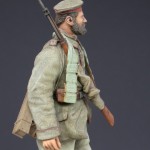
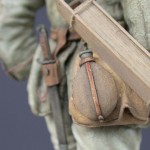
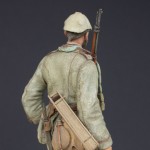
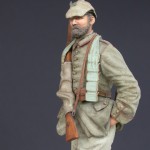
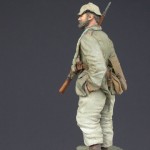
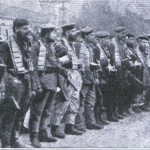
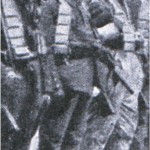
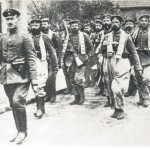
 An deutschsprachige Interessenten:
Sie können mich per eMail oder Telefon auch gerne auf deutsch kontaktieren. Ortsbesuch ist nach Absprache möglich.
An deutschsprachige Interessenten:
Sie können mich per eMail oder Telefon auch gerne auf deutsch kontaktieren. Ortsbesuch ist nach Absprache möglich.